

|

|
IN MEMORIAM
Nina Byers
Professor of Physics & Astronomy
UC Los Angeles
1930 – 2014
Nina was a member of the UCLA faculty over a significant period of growth and change in the department, arriving in 1961 and spending almost her entire career thereafter at UCLA. She was a pioneer in many ways, making an impact in theoretical physics through seminal work in a variety of areas, from particle physics to superconductivity.
Her pioneering role as a woman in physics in a time when this was a lonely classification was also a defining aspect of her career. She led an initiative to document the historic generation of women to which she belonged, developing the website Contributions of 20th Century Women to Physics that brings to life the contributions to science by over 80 female physicists of the 20th century. This work was deepened in the publication of “Out of the shadows: contributions of twentieth-century women to physics” co-edited with Gary Williams.
Nina was born in Los Angeles, California and studied physics at U.C. Berkeley, receiving a B.A. with highest honors in 1950. After Berkeley she became a graduate student at the University of Chicago where she was Murray Gell-Mann's first and last Chicago student before he moved on to Caltech. When Gell-Mann left Chicago, Nina became Gregor Wenzel's student and eventually wrote a thesis on pi-mesic atoms, obtaining her Ph.D. in 1956. Her thesis work is the basis of her first publication "Interactions of Low-Energy Negative Pions with Nuclei," which appeared in the Physical Review in 1957.
After Chicago, Nina had a postdoctoral period at the University of Birmingham, England in R.E. Peierls’ group in the Department of Theoretical Physics. In 1958 she accepted a research associate position at Stanford University, which led to an assistant professorship with a focus on superconductivity.
Nina joined UCLA in 1961 where she turned her attention to particle physics, collaborating on studies in CP-violation and pion-nucleon charge-exchange scattering. In the late sixties and early seventies, Nina was offered a position at Oxford University and split her time between Los Angeles and Oxford. At Oxford, she was the Jane Watson Visiting Fellow in Somerville College and, for a period, a Science Research Council Senior Scientist.
She returned to UCLA in Fall 1973, where her focus in physics had moved to the new gauge theories of the electroweak interactions. Nina's interest in quarkonium and bound state systems was rekindled in the early 1980's, spurred at least in part by her desire to find suitable thesis topics for her students.
This was a very active time in Byers' life, for not only was she doing forefront research with her students, but she was also heavily committed to the affairs of the American Physical Society (APS). Of particular note during this period was the role she played in the Panel of Public Affairs and in the Forum of Physics and Society of the APS, an organization which she chaired in 1982. Her leadership in the AAAS was also notable and she was named a fellow of both societies. Nina served as President of the APS Forum on History of Physics, a position earned through her dedication to promoting the understanding of two weighty subjects: the role of women in physics, and the examination of physicists’ role in the development and deployment of nuclear weapons.
Nina Byers officially retired from UCLA in 1993, but as a Professor Emerita she remained extremely engaged. Partly spurred by her interest in the role of women in academia, soon after retirement, Nina seriously began contemplating establishing a website that would detail the contributions of women to 20th Century physics. After considerable difficulties at first, and with the help of a significant grant from the Sloan Foundation, Nina was finally able to establish this scholarly archive in 1996.
It has been my pleasure to discuss with Nina over the last few years her legacy to the department, in the establishment of the Nina Byers Lectureship, an endowed chair established to invite leading physicists to come to UCLA for several weeks to give a series of talks and interact with our faculty and students. This program is aimed to be a prestigious honor for the Lecturers as well as a mechanism for bringing the excitement of frontier results from external scientists to UCLA, thus raising the level of discourse in the Department.
Corinna Koehnenkemp, Physics and Astronomy